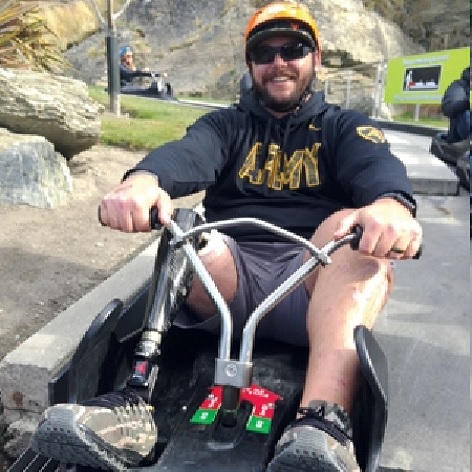Navy Corpsman Ken Swartz lost both legs to an IED in Iraq back in 2010. He made a successful adaptation to traditional socket-based prostheses, but a fall in 2018 left him with a serious muscle tear that kept him off his feet for more than five months.
That was enough to make Swartz inquire about osseointegration (OI), the non-socket alternative in which the prosthesis attaches to anchors embedded within the bone of the residual limb. By attaching the prosthetic limb directly to the skeleton, OI offers greater stability, range of motion, and freedom of mobility than conventional socket devices. It also liberates amputees from socket-related problems such as skin irritations, sores, and excessive perspiration.
In 2020 and 2021, Swartz underwent OI surgery at Johns Hopkins as part of a clinical trial that helped one of the major osseointegration systems—Integrum’s OPRA Implant System—gain FDA approval in the United States. The results have been transformative, Swartz says.
“I love the freedom osseointegration has provided for me,” he told Vantage Point, a VA publication. “It’s helped more in daily life. I can stand longer than I used to stand. That helps in my professional life because I don’t have to worry so much about the physical limitations. I have better balance and alignment, and that helps in the gym and gives me greater confidence.”
In January 2022, the VA began offering OI to veterans with above-knee amputations. Osseointegration surgery and rehabilitation care is now available at several VA Amputation System of Care specialty locations across the country.
“This technology has been a game-changer for amputees by providing a greater sense of mobility and independence for our veterans,” says Patty Young, national program manager of the VA Amputation System of Care. But it’s not the right solution for everyone. Bone density, residual limb dimensions, coexisting health indicators, and various other factors can affect whether OI is likely to succeed for a given individual. It’s also not typically recommended for those who’ve made a successful adaptation to socket-based prosthetic technology.
Even those who do fit the profile of a successful OI candidate may decide the risks aren’t worth the potential rewards. “It’s a complex procedure with a two-stage surgical approach process over the course of six months and a time commitment to rehabilitation of over one year from the first surgery,” Young says.
If you’re in the VA system and want to consider osseointegration, schedule an initial screening with your local VA Amputation Care Team.
